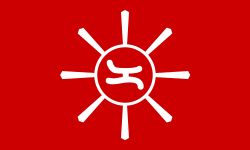 Flag of the Magdalo faction | |
| Type | Political faction |
|---|---|
| Headquarters | Kawit, Cavite |
Faction leader | Baldomero Aguinaldo |
Key people | Emilio Aguinaldo Licerio Topacio Cayetano Topacio Candido Tirona Edilberto Evangelista |
Parent organization | Katipunan |
The Magdalo was a faction of the Katipunan (a Philippine revolutionary organization with the aim to gain independence from Spain during the Philippine Revolution) chapter in Cavite. It was named after Mary Magdalene, patroness of Kawit, Cavite. It was officially led by Baldomero Aguinaldo, but his cousin Emilio Aguinaldo (whose own Katipunan codename was "Magdalo") was its most famous leader. [1] : 22
Contents

The Magdalo was often militarily separated and conflicted with the Magdiwang faction's chapter in Cavite. When the Manila-based Katipunan supreme leader Andres Bonifacio went to Cavite to mediate between the two factions, the Magdalo argued to replace the Katipunan with a revolutionary government. [1] : 90 The Magdiwang under Bonifacio put forth that the Katipunan already served as the government. However, the two factions agreed to convene at Tejeros to form a new unified government, and from the combination of representatives from both factions, Emilio Aguinaldo was elected president.
Some of the civil and military officials of the First Philippine Republic came from the Magdalo.